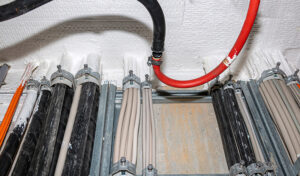Fire blocking is an essential part of protecting lives and property in case of a fire. Commercial property owners should do their best to pay attention to this as it is crucial for creating a safe environment. Moreover, proper fire blocking is not only in keeping with building codes but it can also protect investments.
What Is Fire Blocking?
Fireblocking is a method used in infrastructure to prevent undetected fire and gases from spreading and moving to other areas. It involves installing building materials to cut off hidden vertical and horizontal draft openings. Fires often spread through paths of least resistance like voids, spaces, and cavities within attics, walls, and other assemblies. These spaces allow fire to spread faster and make it harder to suppress. Fire blocking uses barriers to stop or slow fire spread in these spaces.
Fire Block vs Fire Stop
It’s important not to confuse fire blocks and fire stops. The latter is primarily mandated by building codes requiring higher fire protection grades. Its main purpose is to stop a fire from spreading between compartments through utility and service openings in walls, floors, roofs, and ceilings. Meanwhile, fire blocks are usually installed at connections between vertical and horizontal spaces in walls, ceilings, and wall assembly stud cavities. They also exist in furred spaces, openings for penetrations, and between a top story and roof.
Fire Blocking Code
The International Building Code (IBC) outlines specific fireblocking requirements and configurations. Section 717.2.1 includes the acceptable materials to use as fire blocks including 2-inch nominal lumber, gypsum board, structural wood panels, loose-fill insulation like fire blocking foam, and sealants. Property owners should make sure to follow these to meet the IBC’s requirements.
In addition, the code requires certain areas to be sealed or protected aside from fireblocks in walls. For example, fireplaces and chimneys need to be blocked and tested. Moreover, the code requires that buildings must use noncombustible sealants in other areas unrelated to a fire block but serve a similar purpose. Finally, the locations of these fire blocking framing and mechanisms must be indicated in construction documents. They are also subject to inspection before the new building can be occupied.
 Why Is Fire Blocking Important?
Why Is Fire Blocking Important?
Fire blocking is usually the most neglected form of fire protection in architectural planning because it’s not often visible. However, it is vital to commercial buildings for several reasons.
1. An Extra Layer of Safety
Property owners often use various fire-protection measures to ensure the building’s fire safety. They may install safeguards like sprinklers and smoke detectors. Property owners may even make sure there’s a proper means of egress in case of emergency. However, fires can start from anywhere — including in concealed areas. It doesn’t always start in places with obviously high-risk places like kitchens or factories.
For example, a small spark from wiring between studs may cause a fire to form. These studs are usually covered in drywall so the fire will remain undetected by the naked eye. This can allow the fire to grow and spread before anyone is alerted. The fire will be harder to put out or suppress, leaving the occupants unsafe. Fireblocks provide an extra layer of safety in these spaces so the building will not be vulnerable.
2. Protects Investments
Fire blocking can not only save people but also the building and other property inside it. If a fire does occur, it won’t spread as quickly or as severely. This allows the firefighters to suppress and put out the flames faster. As a result, property owners can protect their investments and mitigate the damages. They will not need to spend as much on repairs or replacements.
3. Avoiding Liability
A majority of framing inspections require fire blocking. Different states will have their own fire blocking codes that property owners must abide by. Constructing a building or doing business in a space that does not adhere to these codes may result in potential lawsuits. It may also put the property owner in hot water with local authorities.
Fireblocking Locations
Fire block foam and other materials must seal certain areas according to the IBC’s requirements, but the code’s list is far from exhaustive. That said, which areas should property owners focus on when it comes to fire blocking? Here are some locations to consider:
 Ceiling and Floor Levels. The top story and the roof space of a building must have fire blocking.
Ceiling and Floor Levels. The top story and the roof space of a building must have fire blocking.- Furred Walls. There must be horizontal blocking every 10 feet of furred walls. This confines the gases and flames laterally. The top of the spaces between the foundation and the wall must also have fire blocking. Property owners should also remember to seal the areas in double-stud and staggered-stud walls.
- Soffits, Drop, and Cove Ceilings. These spaces need blocking to seal the connections between floors and walls.
- Cutouts for Drop-in Tubs, Drains, and Showers. These cutouts can leave interconnections between floors and walls. The property owner must address the drains or their rims.
- Cables, Pipes, and Other Penetrations. Penetrations often leave openings and pathways throughout the structure. Drill a slightly bigger hole and fill it using approved material during fireblocking installation.
- Fireplaces and Chimneys. These structures often have gaps between the flammable framing and masonry. This can create a pathway from the roof to the basement and let fires spread rapidly. A noncombustible material must block the gaps at least 1 inch deep.
- Hidden Areas Between Stair Stringers. Property owners must block the top and bottom of these concealed spaces so fires cannot easily spread between floors. Fire blocks must create barriers between the stringers and floor systems at either end of the stairs.
Protect Your Property from Fires
Fire blocking is an essential part of protecting any commercial building or facility. Without it, fires and combustible gases can spread easily throughout the structure, leaving it vulnerable. This can cause damages beyond repair and endanger the lives of the occupants. It can potentially lead to lawsuits from customers, employees, and visitors. Property owners should make it a point to use fire blocking mechanisms to protect people and their investments.
Maintenance Specialists Inc. provides industry-leading commercial building maintenance services. Call us today at 704.405.6000 or contact us online to find out about how we can help you!
RELATED ARTICLES:
- Why Is Sealing Air Barriers Penetrations In A Commercial Building Crucial?
- Commercial Roof Leaks: Causes, Signs, And Repair
- The Phases Of Post Construction Cleaning And Why Hiring The Pros Is Better

